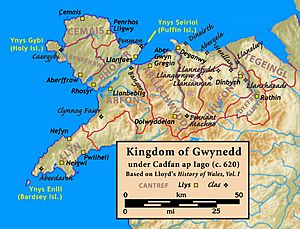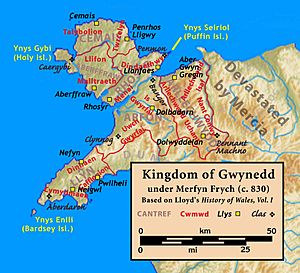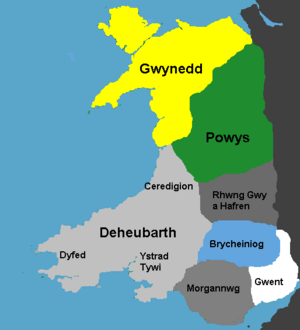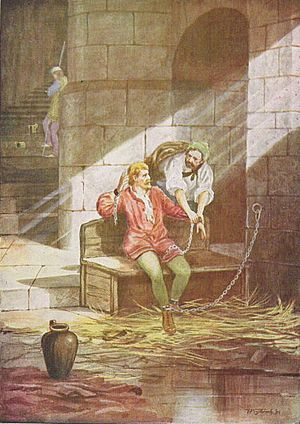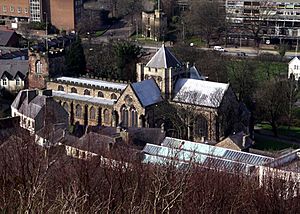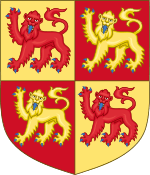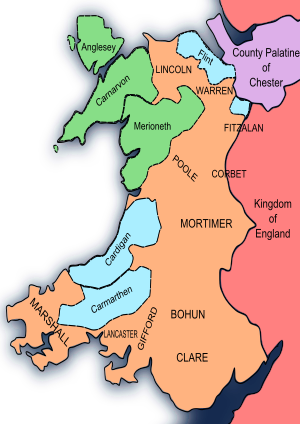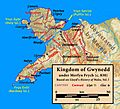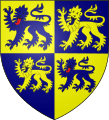Kingdom of Gwynedd facts for kids
Quick facts for kids
Kingdom of Gwynedd
Teyrnas Gwynedd (Welsh)
|
|||||||||
|---|---|---|---|---|---|---|---|---|---|
| 401–1216 | |||||||||
|
Llywelyn banner of the House of Aberffraw
|
|||||||||
|
Anthem: Unbennaeth Prydain
"The Monarchy of Britain" |
|||||||||
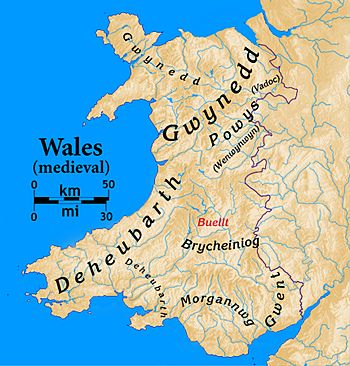
Medieval kingdoms of Wales.
|
|||||||||
| Capital | Chester (?) Deganwy (6th century) Llanfaes (9th century) Aberffraw(9–13th century) Rhuddlan (11th century) Abergwyngregyn (12–13th century) |
||||||||
| Common languages | Welsh, Latin | ||||||||
| Religion | Celtic Christianity | ||||||||
| Government | Monarchy | ||||||||
|
• 401–440
|
Cunedda | ||||||||
|
• 520–547
|
Maelgwn Gwynedd | ||||||||
|
• 625–634
|
Cadwallon ap Cadfan | ||||||||
| Historical era | Middle Ages | ||||||||
|
• Established
|
401 | ||||||||
|
• Declaration of the Principality of Wales
|
1216 | ||||||||
| Population | |||||||||
|
• c. 1271
|
200,000 | ||||||||
| Currency | ceiniog cyfreith ceiniog cwta |
||||||||
|
|||||||||
| Today part of | |||||||||
|
In Latin, Gwynedd was often referred to in official medieval charters and acts of the 13th century as Principatus Norwallia (Principality of North Wales).
|
|||||||||
The Kingdom of Gwynedd was a powerful Welsh kingdom that started in the 5th century. It grew out of sub-Roman Britain after the Roman Empire left. This happened during the time when Anglo-Saxons were settling in Britain.
Gwynedd was located in northwest Wales. Its rulers often became very strong, sometimes even called "King of the Britons". But they could also lose power due to civil wars or invasions. For example, the kingdom of Gruffydd ap Llywelyn was broken by a Saxon invasion in 1063. This was just before the Normans invaded Wales.
However, the House of Aberffraw family, brought back by Gruffudd ap Cynan, slowly regained strength. Llywelyn the Great of Gwynedd was so powerful that he declared the Principality of Wales in 1216. This happened at a meeting of Welsh princes in Aberdyfi. Later, in 1277, the Treaty of Aberconwy was signed between Edward I of England and Llywelyn's grandson, Llywelyn ap Gruffudd. This treaty meant peace, but it also ensured that Welsh self-rule would end when Llywelyn died. This marked the start of Edward I's conquest of Wales.
Welsh stories say that Gwynedd was founded by people from Gododdin (a Brittonic group from Scotland). They invaded lands in Wales in the 5th century. The sons of their leader, Cunedda, were said to have taken control of the land between the Dee and Teifi rivers. The actual borders of Gwynedd changed over time. But it usually included Anglesey and the mountainous Snowdonia region.
Contents
What Does Gwynedd Mean?
The name Gwynedd likely comes from an old Irish word. It might mean "Forest People" or "Wild People." Or it could mean "war band." This suggests that Irish people settled in the area long ago.
In the 1st century, the Llŷn Peninsula was called the "Promontory of the Gangani" by Ptolemy. This name was also used in Ireland. Some believe the Gangani tribe might have arrived in Llŷn and pushed out other tribes. Later, Irish people from Leinster may have come to Anglesey. The name Llŷn itself might come from Laigin, an old Irish word for "Leinstermen."
The oldest record of the name "Gwynedd" is from the 5th century. It's on the Cantiorix Inscription in Penmachno church. It says: "Cantiorix lies here. He was a citizen of Gwynedd and a cousin of Maglos the magistrate." Words like "citizen" and "magistrate" show that Roman culture and ways of life continued in Gwynedd for a long time after the Romans left Britain.
A Look at Gwynedd's Past
The story of the Kingdom of Gwynedd starts with the history of Wales. After the last ice age, people settled in Wales during prehistoric times. Tools made from flint have been found, like a 6000-year-old long house near Llanfaethlu. Other ancient sites in Gwynedd and Anglesey include Bryn Celli Ddu on Anglesey, built 5000 years ago.
Archaeological finds from the Bronze Age (thousands of years ago) include the Arthog cauldron. This bronze cauldron from 1100 BC was found near the Merioneth border. The Moel Hebog shield is also 3,000 years old. More recently, the Trawsfynydd tankard, used for drinking mead and beer, dates from 100 BC to 75 AD.
Early settlements in Gwynedd include Bryn Eryr near Llansadwrn, Anglesey. You can see a recreation of it at the St Fagans National Museum of History. Another is Garn Boduan, a Celtic hillfort on the Llŷn Peninsula. These Iron Age forts were used even after the Roman conquest of Britain. Garn Boduan was fortified until the 7th century.
During the Roman period, new roads and forts were built. Examples in Wales include Caer Gybi (fort) on Anglesey and Segontium in Caernarfon. Christianity in Wales also began during this time. The Romans founded towns with churches and set up governors. After the Romans left, new political groups formed. The Brythonic Kingdom of Gwynedd, founded in the 5th century, was the strongest and lasted until the late 13th century.
Many names and borders from the 1st millennium AD are still used today for towns and counties. Important people who descended from the Kingdom of Gwynedd include Owain Glyndŵr and the Prince of Wales. The Tudors of Penmynydd family from Anglesey were also descendants. They were ancestors of the English Royal House of Tudor, including Henry VII of England. This family claimed descent from Cadwaladr, a former king of Gwynedd. Henry VII even used his 'Red Dragon' banner at the Battle of Bosworth Field.
Gwynedd in the Early Middle Ages
Cunedda and Early Kings
The region was called Venedotia in Latin. It first referred to an Irish settlement on Anglesey. But by the 5th century, it meant all Irish settlers in North Wales. A monk named Nennius wrote in the 9th century that North Wales was left open to raids after the Romans left. So, Cunedda and his family moved from Scotland in the mid-5th century. They came to defend North Wales from raiders and bring it under Romano-British control. It's not clear if they were invited or if they were raiders themselves.
After Cunedda died, Gwynedd was divided among his sons. His grandson, Cadwallon Lawhir ap Einion, finally defeated the Irish on Anglesey. This helped to make Gwynedd a strong kingdom. The people of Gwynedd remembered their Roman past. They used Latin in writing and kept the Christian religion. Their rulers often highlighted Roman ancestors to show their link to the old Roman order. This suggested stability and continuity.
However, many Roman ways were quickly abandoned. Things like coinage, complex industries, and even pottery-making skills were lost. People shifted to a more military-focused society. This helped them survive against invaders. Gwynedd was able to resist Germanic invasions better than other areas.
In the time after the Romans, early rulers of Wales and Gwynedd likely controlled small areas. These were similar to the cantrefi (hundreds) described in later Welsh law. Stronger kings took over weaker neighbors. Eventually, a regional prince could rule all of North Wales.
Cunedda's heir, Einion Yrth ap Cunedda, defeated the remaining Irish on Anglesey by 470. His son, Cadwallon Lawhir ap Einion, made the kingdom stronger after the Battle of Badon. After Cadwallon, Gwynedd became the most important of the Welsh states. Maelgwn Hir (Maelgwn the Tall), Cunedda's great-grandson, was a skilled military leader. He was known for being impulsive and generous. Some stories say he hosted the first Eisteddfod (a Welsh festival of literature, music, and performance). A Christian writer named Gildas criticized Maelgwn and four other British kings for their sins. Gildas called Maelgwn "the dragon of the island" and the most powerful of the five kings.
Maelgwn died from the plague in 547. This led to problems over who would rule next. His son-in-law, Elidyr Mwynfawr, tried to take the throne but was killed. His relatives then attacked Gwynedd. Maelgwn's son, Rhun Hir ap Maelgwn, fought back. The long distances these armies traveled suggest they moved across the Irish Sea. Rhun returned to Gwynedd, and his reign was mostly peaceful until he was killed in another conflict. He was followed by Beli around 586.
When Beli's son Iago ap Beli became king around 599, Britain was in trouble. Most of northern England was taken over by the Angles, who were forming the Kingdom of Northumbria. Gwynedd and the Kingdom of Powys worked together to fight the Angles. But they were defeated at the Battle of Chester in 613. After this, the borders of northern Wales were set. The city of Chester and the surrounding area fell to the Anglo-Saxons.
Cadwallon and Cadwaladr
The Welsh could still threaten the Anglo-Saxons. One of the most powerful early kings was Cadwallon ap Cadfan (around 624–634). He was the grandson of Iago ap Beli. He started a difficult campaign against Northumbria. After several defeats, he was forced to flee to Dublin. But Cadwallon gathered a huge army. He allied with the pagan Penda of Mercia against Northumbria. Cadwallon returned, defeated Northumbrian armies, and killed their kings. In 633, his armies destroyed Northumbria, captured York, and briefly controlled the kingdom. Many Northumbrians were killed by Cadwallon.
Despite many battles, Cadwallon married Alcfritha, daughter of Pybba of Mercia. But he died in battle in 634 at the Battle of Heavenfield. Because of his actions, he and his son Cadwaladr were seen as the last two High Kings of Britain. Cadwaladr focused on strengthening the kingdom and the Church. He earned the title "Bendigaid" (Blessed). Later in life, he became a monk. The Tudors of Penmynydd and Henry VII of England claimed to be descended from Cadwaladr. Henry VII even raised his 'Red Dragon' banner at the Battle of Bosworth Field.
Rhodri the Great and Aberffraw's Importance
During the late 9th and 10th centuries, Vikings often attacked the coastal areas of Gwynedd, especially Anglesey. These raids weakened the country. Luckily, the Vikings also attacked other parts of Britain. The original ruling family, the House of Cunedda, ended in 825 when Hywel ap Rhodri Molwynog died. A new ruler, Merfyn Frych (Merfyn "the Freckled"), took the throne.
Merfyn Frych was not a stranger to the royal line. He was related to the old ruling family through his mother, Essyllt. Merfyn married Nest ferch Cadell, the sister of the King of Powys. He founded the House of Aberffraw, named after his main court on Anglesey. It is believed that Merfyn's court collected and wrote down many old Welsh stories.
Rhodri the Great (844–878), son of Merfyn Frych, became very powerful. He added Powys to his kingdom in 855. He also gained control over Seisyllwg through marriage. This made him the first ruler since Cunedda to control most of Wales.
When Rhodri died in 878, Wales was divided again among his sons. Rhodri's oldest son, Anarawd ap Rhodri, inherited Gwynedd. He established the House of Aberffraw as the main ruling family of Gwynedd. This family ruled with few breaks until 1283.
The Aberffraw family claimed to be the most important Welsh lords. They said they had the right to rule Wales because they were direct descendants of Rhodri the Great. This claim was important because it meant they didn't owe their power to the English king. They believed they ruled Wales "by absolute right through descent."
The Aberffraw family was briefly replaced in 942 by Hywel Dda, a king from South Wales. This happened when Idwal Foel, the King of Gwynedd, fought against the English king, Edmund I, and was killed. Hywel Dda sent Idwal's sons into exile and ruled Gwynedd until his death in 950. Then, the House of Aberffraw was restored.
Between 986 and 1081, the throne of Gwynedd was often fought over. Kings were often replaced by rivals. One of these, Gruffydd ap Llywelyn, became king of most of Wales by 1055. He was so powerful he threatened England. But he was defeated by Harold Godwinson in 1063 and killed by his own men.
After the Norman conquest of England in 1066, the Normans started to pressure Gwynedd's eastern border. This was made easier by internal fighting in Wales. Trahaearn ap Caradog took the throne but was challenged by Gruffudd ap Cynan. Gruffudd was an exiled grandson of the old royal line. In 1081, Gruffudd killed Trahaearn in battle. This brought the ancient line of Rhodri the Great back to power.
Gwynedd in the High Middle Ages
Gruffudd ap Cynan's Reign
The Aberffraw family faced many challenges from rivals and England in the 10th and 11th centuries. Gruffudd ap Cynan (around 1055–1137) grew up in Dublin. He regained his kingdom after winning the Battle of Mynydd Carn in 1081. But his victory was short-lived. The Normans invaded Wales after a Saxon revolt in England.
Soon after his victory, Gruffudd was tricked and captured by Hugh d'Avranches, Earl of Chester. Earl Hugh wanted to expand his lands into Wales. By 1094, almost all of Wales was occupied by Norman forces. But their control was weak. Welsh leaders, driven by anger against the cruel invaders, fought back. By 1100, Welsh control was restored over most of Wales.
To control Gwynedd, Earl Hugh had Hervey le Breton made Bishop of Bangor in 1092. But the Welsh people disliked Hervey. He even had to carry a sword for protection.
Gruffudd escaped from prison in Chester. He killed Robert of Rhuddlan in a battle in 1093. By 1095, Gruffudd had regained Gwynedd. By 1098, he allied with Cadwgan ap Bleddyn of Powys. They led the Welsh resistance against the Norman occupation. Earl Hugh and Hugh of Montgomery, 2nd Earl of Shrewsbury advanced their army to the Menai Strait. Gruffudd and Cadwgan planned to fight from Anglesey. Gruffudd hired a Norse fleet from Ireland to stop the Normans from crossing. But the Normans paid the fleet to ferry them to Anglesey instead. Betrayed, Gruffudd and Cadwgan fled to Ireland.
The Normans landed on Anglesey and celebrated with great violence. But a Norse fleet, led by Magnus Barefoot, King of Norway, appeared. In the Battle of Anglesey Sound, Magnus killed the Earl of Shrewsbury with an arrow. The Norse left, leaving the Norman army weak.
The Norman army returned to England. They left a Welshman, Owain ab Edwin of Tegeingl, to control Anglesey and upper Gwynedd. Owain had switched sides to Chester earlier, earning him the name Bradwr ("the Traitor").
In late 1098, Gruffudd and Cadwgan returned to Wales and easily took back Anglesey. Hervé the Breton fled Bangor. Over the next three years, Gruffudd recovered upper Gwynedd. In 1101, after Earl Hugh's death, Gruffudd and Cadwgan made peace with England's new king, Henry I. Henry I recognized Gruffudd's claims to Anglesey, Llŷn, and other lands in upper Gwynedd. Cadwgan regained his lands in Ceredigion and Powys.
This agreement divided Wales into Pura Wallia (Welsh-controlled lands) and Marchia Wallie (Norman-controlled lands). This border stayed mostly stable for nearly 200 years.
After years of war, Gruffudd began to rebuild Gwynedd. He wanted to bring peace so his people could farm without fear. He strengthened royal power in North Wales. He also offered safety to Welsh people displaced from other areas.
Henry I was worried by Gruffudd's growing power. In 1116, he launched a campaign against Gwynedd and Powys. Gruffudd was forced to pay a large fine and show loyalty to the King. But he lost no land or respect.
This invasion affected Gruffudd. He was in his 60s and losing his eyesight. After 1120, his sons Cadwallon, Owain, and Cadwaladr led Gwynedd's army. Gruffudd's plan was to regain Gwynedd's power without angering the English king too much.
Gwynedd Grows Stronger
In 1120, a small border war led to conflict in the Perfeddwlad. Gwynedd took advantage of this. Gruffudd's sons, Cadwallon and Owain, raided Meirionnydd. By 1136, Meirionnydd was firmly under Gwynedd's control. In 1124, Cadwallon killed the three rulers of Dyffryn Clwyd, bringing that area under Gwynedd's control. In 1125, Cadwallon killed the grandsons of Edwin ap Goronwy, leaving Tegeingl without a lord. However, in 1132, Cadwallon was killed in battle by an army from Powys. This stopped Gwynedd's expansion for a while.
In 1136, Gwynedd launched a campaign against the Normans. This was to avenge the death of Gwenllian ferch Gruffudd ap Cynan. She was Gruffudd's daughter and the wife of the King of Deheubarth. When news of her death reached Gwynedd, Owain and Cadwaladr invaded Norman-controlled Ceredigion. They took several castles and restored Welsh monks to Llanbadarn. By late September 1136, a large Welsh army gathered in Ceredigion. It included forces from Gwynedd, Deheubarth, and Powys. They met the Norman army at the Battle of Crug Mawr. The Normans were soundly defeated.
When their father Gruffudd died in 1137, Owain and Cadwaladr were still fighting in Ceredigion. They took more castles. Gruffudd ap Cynan left Gwynedd a much more stable kingdom than it had been for over 100 years. No foreign army could cross the Conwy into upper Gwynedd. This stability allowed the Welsh to plan for the future without fear of invasion.
Settlements became more permanent, with stone buildings replacing wooden ones. Many stone churches were built across Gwynedd. Gruffudd built stone churches at his royal manors. This led to other churches being rebuilt in stone.
Gruffudd supported the Episcopal See of Bangor. He funded the building of Bangor Cathedral. Gruffudd was buried in a tomb in the cathedral.
Owain Gwynedd's Rule
Owain ap Gruffudd (around 1100–1170) became known as Owain Gwynedd. He took over most of Gwynedd after his father's death. This was according to Welsh law. His younger brother, Cadwaladr, inherited some lands, including Anglesey.
In 1141, Cadwaladr joined the Earl of Chester in the Battle of Lincoln. This battle led to the capture of Stephen of England. Owain, however, kept most of Gwynedd's army at home.
Owain and Cadwaladr had a conflict in 1143. Cadwaladr was involved in the murder of King Anarawd ap Gruffudd of Deheubarth. Anarawd was Owain's ally and was supposed to marry Owain's daughter. Owain wanted to unite Welsh rulers through marriages. Cadwaladr's actions threatened this. Owain took away Cadwaladr's lands. Cadwaladr fled to Ireland and hired a Norse fleet. He brought the fleet to Abermenai to force Owain to give him back his lands. Owain and Cadwaladr eventually made peace. Cadwaladr got his lands back. But in 1147, Owain's sons drove Cadwaladr out of Meirionydd and Ceredigion. He was later forced into exile in England in 1153.
In 1146, Owain's favorite eldest son, Rhun ab Owain Gwynedd, died. Owain was very sad. But news that Mold Castle in Tegeingl had fallen to Gwynedd cheered him up. It reminded him he still had a country to live for.
Between 1148 and 1151, Owain fought against Madog ap Maredudd of Powys and the Earl of Chester. He gained control of Rhuddlan Castle and all of Tegeingl.
Henry II of England decided to act against Owain I of Gwynedd in 1157. Owain's enemies, including his brother Cadwaladr and Madog of Powys, joined Henry II. Henry II marched his army into Wales. Owain set a trap at Dinas Basing. He sent his sons Dafydd ab Owain Gwynedd and Cynan into the woods. They surprised Henry II's army.
Henry II almost died but was rescued. He retreated to his main army. Owain moved further west, allowing Henry II to enter Rhuddlan. Henry II then learned his naval expedition had failed. Instead of meeting him, it had plundered Anglesey. This led to the Battle of Ewloe.
Henry II later wrote about the Welsh: "A people called Welsh, so bold and ferocious that, when unarmed, they do not fear to encounter an armed force, being ready to shed their blood in defence of their country, and to sacrifice their lives for renown."
The naval expedition was led by Henry II's uncle, Henry FitzRoy. They burned churches on Anglesey. But the men of Anglesey gathered and defeated the Norman army. Henry FitzRoy was killed. This defeat convinced Henry II to offer terms.
Owain I of Gwynedd, being wise, agreed to the terms. He paid homage to the King. He gave up Tegeingl and Rhuddlan to Chester. He also restored Cadwaladr to his lands in Gwynedd.
The death of Madog ap Meredudd of Powys in 1160 gave Owain I a chance to expand Gwynedd's influence. Owain continued to expand without angering the English king. He kept a policy of outward peace while secretly strengthening his power. By 1162, Owain controlled the Powys area of Cyfeiliog. He also attacked another Powys area, Arwystli.
In 1163, Henry II had a big argument with Thomas Becket, the Archbishop of Canterbury. This caused problems in England. Owain of Gwynedd joined with Rhys ap Gruffudd of Deheubarth in a second Welsh revolt against Henry II. Henry II gathered a huge army from across his empire. He also paid the Norse of Dublin to attack the Welsh coast.
Henry II found that the war had already started when he returned to England. Owain's son Dafydd was raiding English positions. Henry II rushed to North Wales to strengthen defenses.
The huge army gathered by Henry II was the largest ever for conquering Wales. This made the Welsh allies even closer. Owain I of Gwynedd was the overall commander. He gathered the Welsh army at Corwen.
The English army advanced into Wales through the Ceiriog Valley. They were forced into a narrow line. Owain I had placed skirmishers in the woods who attacked the exposed army. Henry II ordered the woods cleared. But heavy rain flooded the area. His army became stuck in mud. With dwindling supplies and enemy raids, Henry II was forced to retreat completely. He had no victory.
Henry II's Welsh campaign was a total failure. He gave up all plans for conquering Wales. He did not return to England for another four years.
Owain expanded his international efforts against Henry II. He sent a group to Louis VII of France in 1168. They were to negotiate an alliance against Henry II. With Henry II busy with his argument with Thomas Becket, Owain's army took back Tegeingl for Gwynedd by 1169.
Owain I was called princeps Wallensium, which means Prince of the Welsh. This showed his leadership of the Welsh and his victory against the English king. Owain also had a biography of his father written. In it, he claimed his family's right to rule Wales came from Rhodri the Great. Owain I was the oldest male descendant of Rhodri the Great.
Using the title prince instead of king did not mean less status. It showed Gwynedd's ruler in relation to the wider European feudal world. The princes of Gwynedd had more status than many English nobles. They were similar in status to the King of Scots. The princes of Gwynedd used feudalism to strengthen their power over lesser Welsh lords. While they recognized the English King's power, they had their own Welsh law and were independent in practice.
Civil War and New Princes
Welsh writings tell of events at the end of the 12th century. The royal court of Gwynedd faced an uprising. This happened after the Norman invasion of Wales and within Owain Gwynedd's own family. Owain had two sons, Rhun and Hywel, who were not considered legitimate heirs. Owain and his father, Gruffudd ap Cynan, both had connections to Norse-Irish families.
Hywel ab Owain Gwynedd briefly became ruler in 1170. But the kingdom was in civil war. Owain Gwynedd's wife, Cristin verch Goronwy, supported her own son, Dafydd ab Owain Gwynedd (Dafydd I), to be Prince. Dafydd I quickly overthrew and killed Hywel in 1171 at the Battle of Pentraeth.
The royal family started to spread out due to these conflicts. Maelgwn ab Owain Gwynedd gained Anglesey. Dafydd I was a Welsh royal, but his parents' marriage was not recognized by the church. Still, he married Emma of Anjou, who was Henry II's half-sister. Dafydd I was ruthless. He imprisoned his brothers to secure his power. He even jailed Maelgwn. Eventually, Dafydd I himself was imprisoned by Llywelyn the Great. This happened after Dafydd lost the Battle of Aberconwy to an alliance of his relatives.
Dafydd I expelled his remaining family rivals and became master of all Gwynedd. In 1175, he imprisoned his brother Rhodri. Dafydd I allied with Henry II in 1173. He received the manor of Ellesmere as a gift when he married Emma.
This was done so Dafydd could rule in peace. But it didn't last. Before the end of 1175, Rhodri escaped and drove Dafydd I from the royal home of Aberffraw. Dafydd I was not heard from for almost 20 years. He was described as a man who kept "good faith and credit by observing a strict neutrality between the Welsh and English."
His brother Rhodri had more adventures. He fell out with other relatives and was driven out of Gwynedd in 1190. Rhodri fled to the Isle of Man. He was briefly brought back in 1193 with help from the King of the Isles. But he was driven out again in 1194.
Dafydd I had a rival in his nephew Llywelyn ap Iorwerth. Llywelyn was born around 1173. His father, Iorwerth Drwyndwn, had been involved in earlier family struggles. As Llywelyn grew up, he decided to claim power in Gwynedd. He allied with his cousins and uncle Rhodri. In 1194, they all united against Dafydd I. Llywelyn fought many battles across Wales, earning him the name 'The Great'. He made alliances in North Wales and with the English Crown. Llywelyn married Joan, Lady of Wales, the daughter of John, King of England.
Princes of Wales (1216–1283)
Llywelyn the Great
See also Llywelyn ap Iorwerth
Llywelyn ab Iorwerth (1173–1240), known as Llywelyn the Great, was the sole ruler of Gwynedd by 1200. He made a treaty with King John of England that year. Their relationship was good for ten years. Llywelyn married John's daughter, Joan, in 1205. When John arrested Gwenwynwyn ab Owain of Powys in 1208, Llywelyn took the chance to take over southern Powys and Ceredigion. He also built Aberystwyth Castle.
In 1210, relations worsened, and John invaded Gwynedd in 1211. Llywelyn was forced to give up lands east of the River Conwy. But he regained these lands the next year by allying with other Welsh princes. He later allied with the barons who made John sign Magna Carta in 1215. By 1216, Llywelyn was the most powerful ruler in Wales. He held a council at Aberdyfi to divide lands among the other princes. Llywelyn signed the Treaty of Worcester with the next King of England, Henry III, in 1218. This treaty officially recognized Llywelyn I as Prince of Wales.
Between 1220 and 1230, Llywelyn strengthened his claim to the Kingship of Gwynedd. He built castles around the kingdom, like Criccieth, Deganwy, Dolbadarn, Dolwyddelan, and Castell y Bere. The Peace of Middle treaty in 1234 brought peace for the rest of Llywelyn's life. Llywelyn had a court similar to the English Crown. He had household members and 12 royal guards. The royal palace had 35 positions, like royal households today.
Llywelyn followed the laws of Hywel Dda. He tried to choose an heir using the Welsh custom of gavelkind. Llywelyn favored his younger son, Dafydd II. He gave his eldest son, Gruffudd, lands to rule. Dafydd II was named heir with the support of King Henry III of England. In 1238, a Welsh Royal council of Princes was held to honor Dafydd. Llywelyn had a stroke in 1239 and retired. He died a year later in 1240.
Prince Dafydd II
Prince Dafydd II (March 1212–1246), son of Llywelyn the Great, became the heir of Gwynedd. King Henry III of England had accepted Dafydd II's claim. But Henry invaded Gwynedd, and Dafydd II had to make peace in 1241. Under the Treaty of Gwerneigron, Dafydd II gave up all his lands outside Gwynedd. Dafydd II was powerful and ruthless. He imprisoned his own brother, Gruffudd, for six years. Gruffudd later died trying to escape from the Tower of London in 1244.
With his main rival dead, Dafydd allied with other Welsh rulers. He began a campaign against the English in Wales. He also communicated with Pope Innocent IV in Rome about his power as ruler of Gwynedd. The campaign was successful. However, Llywelyn's former seneschal, Sir Tudur ap Ednyfed Fychan, was captured by Henry III's forces. Tudur was released in 1247 after swearing loyalty to the King of England. Dafydd II died suddenly in 1246. This ended the succession crisis. His widow, Isabella de Braose, returned to England.
Prince Llywelyn II, The Last
Prince Llywelyn II (1223–1282), also known as Llywelyn, Our Last Leader, was living in Gwynedd when he became ruler. He had fought with his uncle Dafydd II. This gave him an advantage over his older brother Owain, who had been imprisoned in England. Owain returned to Gwynedd after Dafydd II's death. Llywelyn and Owain agreed to share the realm west of Conwy in the Treaty of Woodstock. But this treaty only lasted eight years.
Llywelyn II's younger brother, Dafydd III, was invited by Henry III to pay homage in 1253. But Dafydd III allied with Owain and fought Llywelyn II at the Battle of Bryn Derwin. Llywelyn II won and imprisoned both brothers. Owain was imprisoned until 1277. Dafydd III was imprisoned for about a year. Dafydd III later gained favor with the English Crown. Llywelyn was seen as a leader for the new state of Wales. He worked with the Norman dynasty to the east of Gwynedd. This was made official with the Treaty of Montgomery in 1267.
With his brothers out of the way, Llywelyn II was the sole ruler. He had over a decade of military success. He was helped by the weakness of the English Crown and the support of his seneschal Goronwy ab Ednyfed. He reunited North Wales. Llywelyn II allied with the Montfort family. He married Eleanor de Montfort in 1275. Eleanor was the daughter of Simon de Montfort, 6th Earl of Leicester, who had rebelled in the English civil war. Another Pope, Clement IV, negotiated peace with the Welsh Prince. He insisted Llywelyn break ties with the Montforts. Llywelyn II and Eleanor married twice. Their daughter Gwenllian ferch Llywelyn was orphaned before her first birthday. She was the last of her line.
The title "Prince of Wales" was later given to Prince Edward (who became Edward II). This began the Principality of Wales in 1301. The Treaty of Aberconwy was signed in 1277 by Llywelyn II. It was an agreement to hand over the power Gwynedd had gained in Wales. The new English ruling family, the House of Plantagenet, was of French and Norman origin. However, Llywelyn's brother Dafydd III had other ideas. He attacked Hawarden castle in 1282. In November 1282, the Archbishop of Canterbury tried to make peace. Llywelyn II was offered money and an English estate if he surrendered Gwynedd's territory. Llywelyn II refused. The next month, on December 11, 1282, Llywelyn was killed in an ambush. His head was sent to London.
Prince Dafydd III
After years of conflict in Gwynedd, Dafydd ap Gruffydd (1253–1283), known as Dafydd III, was next to gain the Prince of Wales title. Dafydd III was involved in royal life from a young age. In 1253, he paid homage to the English court. But he soon began military campaigns against his brother Llywelyn II in 1255. Llywelyn II jailed him for a year after the Battle of Bryn Derwin. Dafydd III rebelled against Llywelyn II again in 1263. This time he failed and fled to England. He was offered lands there. Dafydd III joined the English court and stayed in England until 1267.
Another Pope, Ottobuono, negotiated peace between the English and Welsh royal families. Peace lasted for six years. Dafydd III was a counselor to his brother, the Prince of Wales. Peace ended when another plot formed, involving Gruffydd ap Gwenwynwyn, Prince of Powys. Dafydd III was forced to flee to England again. He pledged loyalty to King Edward I in 1274. He was made a knight and considered a friend. In 1277, Dafydd III returned to Wales with Edward I. An agreement was made on how to share the spoils of war. By November 10, Llywelyn I submitted to the English Crown in the Treaty of Aberconwy. Lands in Snowdonia, Anglesey, and Penllyn were shared among the Princes. Dafydd III received a dowry and an estate in Cheshire.
Later in his life, Dafydd III changed his alliance again. He fought against the English Crown, risking being called a traitor. He had the support of Goronwy ap Heilin, Gwynedd's seneschal. He also had support from other Welsh princes. Dafydd III wanted Welsh independence. But his rebellion went against the Treaty of Aberconwy. His attack on Hawarden castle on March 22, 1282, was the final conflict for the Kingdom of Gwynedd.
Dafydd III faced the wrath of the English forces. The Norman army surrounded Snowdonia and starved the Welsh people. Dafydd III moved from one fort to another as resistance was crushed. Dolwyddelan Castle was abandoned in January 1283. Dolbadarn Castle was also threatened by March. Dafydd III was forced to retreat again. Finally, he moved his headquarters south to Castell y Bere. From this point, the Prince, his family, and the remaining Welsh government were fugitives. They slept outdoors and kept moving to avoid capture. Castell Y Bere surrendered on April 25.
On June 21, 1283, Dafydd III was captured in the uplands near Abergwyngregyn. He was caught by "men of his own tongue." The last royal family of Wales was imprisoned. Dafydd III was executed by hanging in Shrewsbury for treason. After the capture of Gwynedd's royal family, the Princes, including Llywelyn ap Dafydd, were imprisoned in Bristol Castle. Daughters became nuns in monasteries.
End of Independence
After Llywelyn II died in 1282, and his brother Dafydd III was executed in 1283, eight centuries of independent rule by the House of Gwynedd ended. The kingdom, which had been one of the last parts of Wales to resist English rule, was taken over by England. The remaining important members of the ruling family were arrested and imprisoned for life.
Under the Statute of Rhuddlan in 1284, Wales was reorganized into six shires (counties). The Snowdonia area in Gwynedd became three counties: Anglesey, Carnarvonshire, and Merionethshire. The rest of Wales was also divided.
Pura Walia was the new name for the Welsh-controlled areas. These were effectively the new counties that had been Gwynedd, Carmarthenshire, and Cardiganshire. Marchia Wallie referred to Welsh lands under Norman control. The Pura Walia continued to be part of a nominal Principality of Wales, ruled by the Council of Wales.
There were many rebellions in Gwynedd after 1284. Most were led by distant relatives of the old royal house. Notable rebellions include those of Prince Madoc in 1294 and Owain Lawgoch (Llywelyn ap Gruffudd's great-nephew) between 1372 and 1378. Because of this, the old royal house was largely wiped out, and any survivors went into hiding. A final rebellion in 1400 was led by Owain Glyndŵr, from the rival royal house of Powys. This rebellion also gained much support from Gwynedd.
The title "Prince of Wales" was recreated after Llywelyn II. Prince Edward (later Edward II) was given the title in 1301 at Caernarfon castle. This began the Principality of Wales. The Welsh Marches (border lands) were merged with the principality in 1534. All separate governance for Wales ended later.
Military Tactics
According to Sir John Edward Lloyd, fighting in Wales was difficult. If defenders could block roads, river crossings, or mountain passes, and control the coastline, it was very risky for invaders.
Gerald of Wales described the Welsh way of fighting around 1190: "Their fighting style involves chasing the enemy or retreating. This lightly armed people, relying on speed more than strength, cannot fight long, close battles. Though defeated one day, they are ready to fight the next. They are not sad about losses. While they may not show great bravery in open battles, they bother the enemy with ambushes and night raids. They are not bothered by hunger or cold, nor tired by war. They are ready to fight again after a defeat."
The Welsh were known for their skilled archers. They also learned from their Norman rivals. Over generations of fighting, Welsh leaders like Gruffudd ap Cynan learned knightly skills. By Gruffudd's death in 1137, Gwynedd could field hundreds of heavily armed cavalry, as well as their traditional archers and foot soldiers.
"They use light weapons that don't slow them down. Small chainmail coats, bundles of arrows, and long spears. Helmets and shields, and sometimes iron leg guards. The higher-class men ride fast horses. But most people fight on foot because the land is marshy and uneven. Horsemen can fight on foot when needed. They either walk barefoot or wear rough leather shoes. In peacetime, young men practice by going deep into woods and climbing mountains. They learn to endure being tired day and night."
In the end, Wales was defeated because the English navy improved. They could block or seize areas important for food, like Anglesey. If an army controlled the Menai Strait, they could regroup on Anglesey. Without control, an army could be trapped. And an occupying force on Anglesey could prevent the Welsh from getting the island's large harvest.
Lack of food would force any large Welsh army trapped in the mountains to break up. After the conquest, Welsh soldiers were forced to serve in the English Army. During Owain Glyndŵr's revolt, the Welsh used their new skills for guerrilla tactics and quick raids. Owain Glyndŵr was so good at using the mountains that many English soldiers thought he was a magician who could control nature.
How Gwynedd Was Run
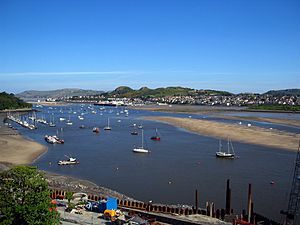
In early times, Gwynedd might have been ruled from Chester. After the Battle of Chester in 613, the royal court moved west to Deganwy Castle. This site was destroyed and rebuilt several times. Later, Aberffraw on Anglesey became the main power center. However, as the English fleet grew stronger, Aberffraw became hard to defend. From about 1200 to 1283, Abergwyngregyn (or "Aber") was the new royal home. Many important people died there, including Joan, Lady of Wales, in 1237, and Eleanor de Montfort, Lady of Wales, in 1282. The English Crown took over the royal home in early 1283.
The traditional area of Aberffraw's influence included Isle of Anglesey (Ynys Môn), Gwynedd Uwch Conwy (upper Gwynedd), and the Perfeddwlad (lower Gwynedd). Other lands were gained through loyalty or conquest. But these areas were always seen as additions to Gwynedd, not part of it.
After the Norman conquest, people from Llanfaes were moved to make way for Beaumaris Castle on Anglesey. The newly built Llys Rhosyr replaced the old Llys Aberffraw. It was one of three main courts on Anglesey. These courts (Welsh: Llysoedd) were royal homes and administrative centers. They collected taxes and functioned like modern government buildings.
Gwynedd was traditionally divided using natural borders, like the Conwy and Dee rivers. This created Gwynedd Uwch Conwy and Gwynedd Is Conwy. The kingdom was managed through thirteen Cantrefi. Each cantref theoretically had one hundred settlements. Most cantrefs were also divided into smaller areas called cymydau (English commotes). A full list was created in the Red Book of Hergest in the late 14th century.
Legacy of Gwynedd
After Edward's conquest, the lands of Gwynedd were divided into the English counties of Anglesey, Caernarfonshire, Merionethshire, Denbighshire, and Flintshire. The Local Government Act 1972 later created a new county called Gwynedd. This new county included Anglesey and parts of the mainland. The modern principal area of Gwynedd, created in 1994, no longer includes Anglesey.
See also
- List of rulers of Gwynedd
- House of Aberffraw
- King of Wales
- Family tree of Welsh monarchs
- King of the Britons
- List of legendary kings of Britain
Images for kids
-
Gravestone of Cadfan ap Iago, father of Cadwallon ap Cadfan
-
Gruffudd's remains were interred in a tomb in the presbytery of Bangor Cathedral
-
The Afon Conwy is the traditional border between upper and lower Gwynedd





